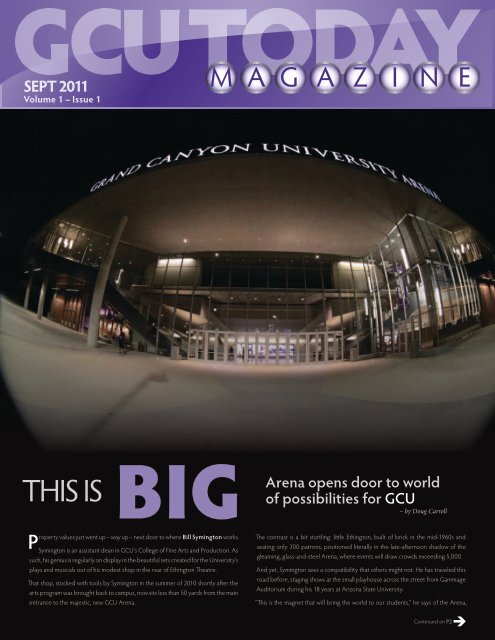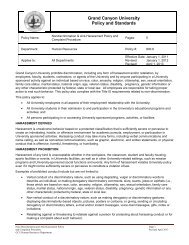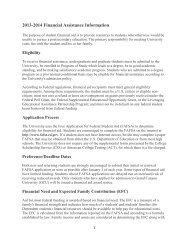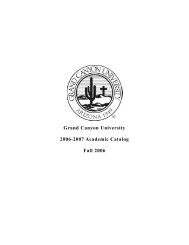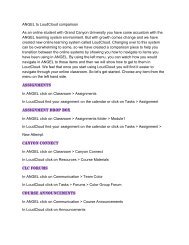Property - Grand Canyon University
Property - Grand Canyon University
Property - Grand Canyon University
You also want an ePaper? Increase the reach of your titles
YUMPU automatically turns print PDFs into web optimized ePapers that Google loves.
SEPT 2011<br />
Volume 1 – Issue 1<br />
<strong>Property</strong> values just went up – way up – next door to where Bill Symington works.<br />
Symington is an assistant dean in GCU’s College of Fine Arts and Production. As<br />
such, his genius is regularly on display in the beautiful sets created for the <strong>University</strong>’s<br />
plays and musicals out of his modest shop in the rear of Ethington Theatre.<br />
That shop, stocked with tools by Symington in the summer of 2010 shortly after the<br />
arts program was brought back to campus, now sits less than 50 yards from the main<br />
entrance to the majestic, new GCU Arena.<br />
The contrast is a bit startling: little Ethington, built of brick in the mid-1960s and<br />
seating only 300 patrons, positioned literally in the late-afternoon shadow of the<br />
gleaming, glass-and-steel Arena, where events will draw crowds exceeding 5,000.<br />
And yet, Symington sees a compatibility that others might not. He has traveled this<br />
road before, staging shows at the small playhouse across the street from Gammage<br />
Auditorium during his 18 years at Arizona State <strong>University</strong>.<br />
“This is the magnet that will bring the world to our students,” he says of the Arena,
Right Here, Right Now P3<br />
The Gift P6<br />
Thunder Alley P7<br />
Online Faculty P7<br />
FEATURE<br />
Volume 1 – Issue 1<br />
P4-5<br />
GCU Today MaGazine is a<br />
quarterly publication of the Office of<br />
Communications and Public Affairs at<br />
<strong>Grand</strong> <strong>Canyon</strong> <strong>University</strong>.<br />
Written and edited by<br />
DOUG CARROLL<br />
Communications Manager<br />
ZANE EWTON<br />
Communications Specialist<br />
JENNIFER WILLIS<br />
Communications Specialist<br />
designed by<br />
DEANNA FUSCO<br />
SoHo Southwest<br />
Photos by<br />
ZANE EWTON<br />
office of Communications<br />
and Public affairs<br />
BILL JENkINS<br />
Executive Director<br />
ConTaCT<br />
DOUG CARROLL<br />
doug.carroll@gcu.edu | 602.639.8011<br />
ZANE EWTON<br />
zane.ewton@gcu.edu | 602.639.7086<br />
JENNIFER WILLIS<br />
jennifer.willis@gcu.edu | 602.639.7383<br />
<strong>Grand</strong> <strong>Canyon</strong> <strong>University</strong><br />
3300 W. Camelback Road<br />
Phoenix, AZ 85017<br />
P2 September 2011<br />
which officially opened on Sept. 1 and already is booked well<br />
into 2012 with basketball games, concerts, lectures and even<br />
an ice show.<br />
“That opportunity has changed our <strong>University</strong>. Connections<br />
will be brought to students, and they won’t have to go looking<br />
for them.”<br />
With the likes of Jayson Adamsen working the Arena, the<br />
pros in the entertainment business now have GCU in their<br />
sights. Adamsen, the production manager for Rhino Staging in<br />
Tempe, has known Symington for years and is looking forward<br />
to showing students what he does and how he does it.<br />
These opportunities have been available to ASU students<br />
over the years with the traveling productions, such as “Les<br />
Miserables” and “The Lion King,” that have played Gammage.<br />
Symington helped with a number of the touring shows.<br />
Adamsen gives the Arena high marks for its ease of load-in, its<br />
power supply and its grid (overhead rigging). Those aspects,<br />
along with the convenience of parking, figure to be pluses in<br />
competing for shows with Comerica Theatre (formerly the<br />
Dodge) in downtown Phoenix, which seats 5,500.<br />
“There’s a niche in the (Phoenix) market for this,” Adamsen says,<br />
“and my initial impression is: What a great venue.”<br />
The trend in the industry is to build smaller. The 17,000-seat<br />
arenas are expensive to construct and maintain, and they’re<br />
difficult to fill with paying customers when the economy goes<br />
(and stays) south.<br />
The new template is symbolized by Tim’s Toyota Center in<br />
Prescott Valley, a 5,000-seat venue built in 2006 that hosts<br />
concerts, minor-league hockey and indoor football. Wells<br />
Fargo Arena, the home of ASU’s basketball teams since 1974,<br />
has reduced its seating capacity in an attempt to create a more<br />
intimate setting.<br />
Continued from P1<br />
“This is where you want to be (in size),” Symington says of GCU<br />
Arena. “It’s lean and mean. It’s like the small, busy restaurant<br />
with the line out the door.<br />
“Some places are great for some events but not for others. They<br />
might work for sports but not for concerts. This is adaptable.<br />
It’s gorgeous, and there’s not a bad seat in it. It’s just fantastic,<br />
and its potential is off the charts.”<br />
GCU students can’t believe their good fortune. They realize<br />
they’re in on the ground floor of something special.<br />
“You can say that it’s not all about the Arena, but it is,” says<br />
transfer student Antoinette Proctor. “This is really going to<br />
draw people in. It’s awesome that we have a campus like this<br />
and a place like this.”<br />
Freshman Phil Ogan says GCU has made a bold statement<br />
with such a facility, adding that it “seems like a place the Suns<br />
would play in.”<br />
The Arena’s high-definition video boards are bound to appeal<br />
to speakers and conventions, Symington says, and even the<br />
spacious plaza and grassy quadrangle on the Arena’s north<br />
side are enticing in ways the campus hasn’t seen before.<br />
West Phoenix stands to be a beneficiary of the increase in<br />
activity at 33rd Avenue and Camelback Road.<br />
“People will come here who may not have thought of coming<br />
to campus for any reason,” Symington says. “The glass exterior<br />
has this open, inviting appearance. At other places, the<br />
people who go (to a venue) are the ones who already know<br />
what’s going on inside.<br />
“With this, people will wonder, ‘What’s happening in there?’”<br />
The new GCU Arena will be the<br />
centerpiece of the RUN TO<br />
FIGhT ChILDREN’S CANCER<br />
on campus Saturday, Oct. 15. Two<br />
races – a 10K (6.2 miles) and a 5K –<br />
plus a Cancer Survivors’ Walk will be<br />
held, with all proceeds benefiting<br />
the Children’s Cancer Network.<br />
This is the first time GCU has<br />
hosted road races on campus. The<br />
first 500 runners to register will<br />
receive a free pair of racing socks,<br />
and all participants will receive a<br />
commemorative T-shirt. Sponsors<br />
include Bank of America, the<br />
Arizona Diamondbacks, the<br />
Phoenix Suns and Phoenix<br />
Children’s hospital. Chip timing<br />
will be provided by Raceplace<br />
Event Systems.<br />
The 10K will start at 7:30 a.m.,<br />
the 5K at 7:40. The courses are<br />
flat and fast and will start and<br />
finish near the Arena, which will<br />
be open to visitors. For more<br />
information and to register, go to<br />
runtofightcancer.com.
RIGHT HERE<br />
Our campus, always special,<br />
has become extraordinary<br />
For those of us who were around over the<br />
summer, it was a dusty, roundabout adventure<br />
to get across campus. The east-west route across<br />
the center of campus was closed, and construction<br />
fences abounded. But I was excited. This was one<br />
of the first summers in the school’s history when I<br />
could truly say I envisioned the great environment<br />
we will have this year.<br />
I toured the campus in early August, taking in all the<br />
building that was going on, from the Arena, to the<br />
east-west promenade, to the plumbing work on the<br />
north-south promenade, to the new dining facility,<br />
to Prescott Hall, to the new parking lot going in<br />
where the southwest lawn used to be.<br />
I experienced a few twinges of nostalgia. Like<br />
J.R.R. Tolkien, trees tend to be my friends, so I<br />
missed some of the mature ones that used to be<br />
the best feature of the old campus. I also missed<br />
Founders’ Plaza, which is gone for the moment. But<br />
if you walked around campus, you could see all<br />
the preservation taking place: There were stored<br />
mature trees all around, including a huge palm tree<br />
behind the Wallace Building on Administration<br />
Avenue. The actual Founders’ Plaza stones, plaques<br />
and sculpture were preserved on pallets, for<br />
reconstruction in the new landscaping.<br />
As I say, the trees and the big front lawns were the<br />
best part of the old GCU campus. The buildings,<br />
not so much. I’ve walked this campus many times<br />
during my 19 years here, and this is the time I’ve<br />
been most happy and excited. In the old days, a<br />
street ran down what is now the north-south<br />
promenade, straight to the commuter parking lot.<br />
I always hated that parking lot; now it’s a beautiful<br />
intramural field, a central recreation area for the<br />
campus, bounded by promenades and academic<br />
buildings, including the beautiful new residence<br />
hall. I hear that the view from Prescott Hall’s fifth<br />
floor is amazing – downtown Phoenix, the South<br />
Mountains, Camelback Mountain and Piestewa<br />
Peak. If you look west, I bet you can see the White<br />
Tank Mountains.<br />
We now have a pedestrian campus, which I think is<br />
better for my own fitness, at least. It’s also a human<br />
campus. We have plenty of places – lawns, the new<br />
dining commons, the Student Union, residence-<br />
hall courtyards, lounges, the wi-fi enabled halls<br />
and promenades – to connect with one another in<br />
rich ways. I love to walk in beauty, and we have it in<br />
abundance in the new landscaping and buildings.<br />
In the old days, if you saw a portable building, you<br />
knew it was going to stay put awhile; now we have<br />
beautiful, quality buildings going up almost every<br />
term. Students can spend their whole social lives on<br />
campus if they want, and not be deprived. And in<br />
the new Arena, the view from the concourse level<br />
is to die for, and the space itself is both visually and<br />
acoustically excellent. I can’t wait for our first events<br />
in there.<br />
In the old days, we had a 10-year master plan. The<br />
way we were going to grow the campus looked<br />
much the way the campus has actually grown. It’s<br />
great to see our dreams for the physical campus<br />
coming true.<br />
RIGHT NOW<br />
Three years later, a big decision<br />
looks better than ever<br />
Words can’t describe the way the GCU<br />
campus has changed over the years.<br />
As a freshman three years ago, I never would have<br />
imagined the transformation now taking place,<br />
literally right before my eyes. There probably are<br />
just a few students on campus who remember<br />
the old tennis courts just north of the Enrollment<br />
Center or the old days at the church softball fields.<br />
Over the last year and a half, it has been hard to<br />
notice anything but the appealing architecture and<br />
beautifully constructed buildings – not to mention<br />
the dust, fences and constant flow of construction<br />
traffic. Although it’s difficult to think past the beauty<br />
and blessings of such change, I can’t help but think<br />
about more.<br />
I can’t stop thinking about choices.<br />
All of the change and construction is linked to<br />
making choices: where to build the next dorm,<br />
what color to paint the walls, what to name the new<br />
facilities. Although these are important, I have a<br />
different choice in mind.<br />
In a truly magnificent way, choices determine the<br />
course of our lives. We make choices every day,<br />
Left: Anthony Mann, Right: Dr. James P. helfers<br />
in both big and small ways, uncertain of how a<br />
drastic or subtle result may affect the ways in<br />
which we live.<br />
Three years ago, I made a choice. It was a decision<br />
to leave Arizona State <strong>University</strong>, the place I<br />
had desired to call home. I was scared, unsure<br />
of what was going to happen and constantly<br />
second-guessing my every thought.<br />
Today, I don’t think twice about the choice I<br />
made to come to GCU.<br />
Choices have the ability to change your life, and<br />
for me it all started with one decision. Without<br />
making that move, I might never have had the<br />
opportunity to be a part of the change we’re all<br />
experiencing now.<br />
For me, this is much more than new buildings and<br />
landscapes. It’s comfort and reassurance that I<br />
made the right choice.<br />
So did you.<br />
September 2011<br />
P3
THE<br />
Prescott Hall RAs (from left) Megan Stoykovich,<br />
Robert Ramirez, Kristen Wheeler, Meghan Hartmann,<br />
Kaitlynn Mendenhall and Rhian Whitmarsh.
Thirty years ago, life in a college residence hall was appreciated by students for<br />
what it didn’t have.<br />
Parents.<br />
In exchange for that sweet whiff of independence, a 350-square-foot room with<br />
hard beds, beat-up desks and immovable dressers – plus a communal lavatory down<br />
the hall – worked just fine, providing the necessities of a spartan existence. Could a<br />
couple of 19-year-olds want for more?<br />
Well, yes, and in time they did. Just how much more is seen this fall on the GCU<br />
campus with the opening of Prescott Hall, a five-story, 500-bed residence hall that is<br />
rife with amenities for those who make it their home for eight months.<br />
Architects don’t like to call these places “dormitories” anymore, and indeed Prescott<br />
Hall more closely resembles an upscale urban condo building or a well-appointed<br />
Fairfield Inn. Its extras are fast becoming standard in campus living across the<br />
country: 9-inch-thick pillow-top mattresses, flat-screen TVs, DVD players, custom<br />
study nooks, barbecue grills, in-room snack bars, card-swipe security.<br />
In short, Prescott Hall has it all. It is flush with the comforts of home that the military-<br />
style dorm of yesteryear lacked – and all without a parent in sight.<br />
“People are blown away,” says James Rogers, one of Prescott’s two resident<br />
directors, on a recent tour and photo shoot at the building. “For us, it’s more<br />
opportunity to create community. The new things are great visually, but they also<br />
facilitate community.<br />
“Our residential community (at GCU) has exploded in just two years. It’s an exciting<br />
time. The on-campus experience is so much better.”<br />
Only two years ago, about 350 students lived on the west Phoenix campus, in Hegel<br />
Hall (built in 2003) and the North Rim Apartments (1986). With the opening of<br />
<strong>Canyon</strong> Hall in 2010, the number soared to 1,000, and Prescott Hall’s arrival has<br />
pushed it to 1,600. Work will begin soon on a fourth residence hall, Camelback Hall,<br />
as GCU grows to a projected campus enrollment of 11,000 in the next three years.<br />
Designed by Architekton of Tempe and built by Pono Construction of Glendale,<br />
Prescott Hall features 736-square-foot suites that include two bedrooms, two<br />
bathrooms and a common area for the suite’s four residents. There are 10<br />
handicapped-accessible units.<br />
But that’s not all there is to Prescott. Each floor contains two mid-corridor study<br />
rooms (done in blue), two laundry rooms (green) and two lobbies (deep purple and<br />
burnt orange). These are the inviting spaces – some of them with spectacular views<br />
of campus and beyond – that set the hall apart.<br />
The interior color coordination was an intricate process that consumed Charlie<br />
Sirokman, GCU’s project director, and Julie Gordon, a project engineer for Pono,<br />
for two weeks’ worth of paint chips and carpet samples.<br />
“We didn’t go with neon colors,” says Sirokman, who has built custom homes as<br />
well as facilities on college campuses in Illinois and Washington. “The colors are<br />
subdued, but there’s still a ‘wow factor.’ We used prime colors, but with a different<br />
hue to them.”<br />
The building’s exterior, too, was designed with both form and function in mind,<br />
incorporating “flex space” on the north-side ground level (possibly for offices) and a<br />
U-shaped, artificial-turf courtyard (for group gatherings and small concerts).<br />
The current trend in residence halls is to blur the line between living and learning,<br />
intentionally replacing the old (which emphasized durability and efficiency) with the<br />
new (flexibility, technology and a balance of community and privacy). The number of<br />
residence halls built since 2000 with Internet access in students’ rooms? All of them.<br />
The 21st Century Project, an initiative of the Association of College and <strong>University</strong><br />
Housing Officers, champions this living-and-learning movement, even convening<br />
a summit conference, hosting design competitions and publishing books on the<br />
subject of cutting-edge campus housing.<br />
“It is no longer enough to provide students with four walls and a bed,” the ACUHO<br />
says on its website. “Current and future students demand more from their<br />
residential experience. And administrators have realized that (this) can attract and<br />
retain students.”<br />
In a recent survey of college students by the Center for Facilities Research of the<br />
APPA, residential facilities ranked second in importance during pre-enrollment visits,<br />
behind only facilities related to specific majors.<br />
According to Michael Coakley, executive director of residential life at Arizona State<br />
<strong>University</strong>, an “unsatisfactory housing experience” is the reason most students give<br />
for dropping out of school during their first or second years. The thinking is that nicer<br />
digs contribute to longer stays.<br />
Prescott Hall’s first-year population consists of about 60 percent returning students<br />
and 40 percent freshmen, and Director of Student Housing Eric Andrews predicts<br />
that the freshmen will want to live all four years there. That’s another trend: Schools<br />
are now much more intentional about mixing underclassmen and upperclassmen<br />
than they were in the past.<br />
Men reside on the first and second floors of Prescott, women on the third, fourth<br />
and fifth floors. At $2,100 per semester, it’s an extra $400 annually to live in Prescott<br />
versus Hegel or <strong>Canyon</strong>.<br />
It’s worth it, says Prescott resident adviser Robert Ramirez.<br />
“There are so many more places to hang out and to study,” he says. “They’ve worked<br />
to make every space livable.”<br />
The many conveniences do make old-school dormies wonder: Is it possible for a<br />
residence hall to be too nice, inhibiting the social interaction that naturally comes<br />
from being out and about on campus? Will students just hole up?<br />
“There is some tension between students’ desire for personal space and amenities<br />
and their desire – and need – to meet others and interact,” admits Emily Glenn<br />
of ACUHO.<br />
However, as the opening of Prescott Hall demonstrates, the new wave of residence<br />
halls is here to stay — and there’s no going back.<br />
September 2011<br />
Photo by: Tim Koors<br />
P5
ow good were the President’s Singers during their<br />
choral heyday on the GCU campus?<br />
This good: They once cut a future opera star.<br />
“She’s not going to blend” was what soprano Amber<br />
Wagner heard back in 2001. Wagner had followed a<br />
high school friend from northern California to GCU. As<br />
a sociology major reminded by her engineer father that<br />
she needed a “real job,” a career in music wasn’t even<br />
on her radar.<br />
However, GCU’s vocal coach then and now, Dr. Sheila<br />
Corley, didn’t want to let a prospect get away. Two<br />
months later, she had found scholarship money for<br />
Wagner, who eventually made the elite, 16-member<br />
group that sang in four parts.<br />
“The very first time I heard Amber sing,” Corley says<br />
now, “I recognized that rare voice that God had kissed<br />
with a presence and color that stands alone in beauty<br />
to this day.”<br />
Oh, if those President’s Singers could hear her now.<br />
Wagner, who graduated from the <strong>University</strong> in 2006<br />
and from a prestigious, three-year apprenticeship<br />
at the Ryan Center of Chicago’s Lyric Opera in 2010,<br />
is already landing plum roles in the opera world and<br />
impressing some of classical music’s toughest critics.<br />
This fall, she is singing the role of Anna in Verdi’s<br />
P6 September 2011<br />
“Nabucco” at New York’s Metropolitan Opera. And<br />
then there’s the title role in Strauss’ “Ariadne auf Naxos”<br />
with the Lyric, with six performances starting Nov. 19 in<br />
Chicago. In April, she sang Ariadne with the Canadian<br />
Opera Company, stepping in on only 24 hours’ notice<br />
and receiving rave notices.<br />
“It is a treat to encounter a gifted young singer before<br />
the whole opera world knows about her,” one Toronto<br />
critic wrote.<br />
Wagner is married to Gabe Salazar, a former classmate<br />
at GCU, who directs the New Life Singers – the current<br />
version of the President’s Singers. She delights in telling<br />
stories from her days as a resident of the North Rim<br />
Apartments on campus, when she would drive her car<br />
even the shortest of distances rather than walk.<br />
She’s no diva – far from it – and she credits Corley with<br />
keeping her grounded.<br />
“My story could just as easily be about her,” Wagner<br />
says. “Sheila was the one who poured herself into me.<br />
She believed I had something special to offer. But there<br />
were times when she threatened to pass me off to a<br />
male teacher because I had ‘motivational issues.’<br />
“She always told me, ‘Don’t buy into your own hype.<br />
Get on your knees and thank God for the gift you’ve<br />
got.’ She’s humble, and she teaches her students to be<br />
that way.”<br />
Wagner isn’t the only GCU alumnus making a living in<br />
opera. Aubrey Allicock had a major role this summer<br />
in a revival of “The Death of Klinghoffer” by Opera<br />
Theater of St. Louis. He, too, has received favorable<br />
reviews for his work.<br />
“This can be a great music program again,” Wagner says<br />
of GCU’s recent revival of the College of Fine Arts and<br />
Production. “Rebuilding the talent base can take time.<br />
But it was done before, and it can be done again.”<br />
She says she’ll put her GCU training under Corley<br />
up against anyone’s. The traditional route to the<br />
opera stage is through study at a high-profile school<br />
or conservatory, and the publication Opera News<br />
recently debated the issue in print:<br />
“If the goods, the guidance, the fire in the belly and<br />
curiosity to learn are there – what difference does it<br />
make where a singer goes to school?<br />
“Case in point: Soprano Amber Wagner came to<br />
Chicago’s Ryan Center after graduating from – wait for<br />
it – <strong>Grand</strong> <strong>Canyon</strong> <strong>University</strong>. ... Within a few seasons,<br />
Wagner was singing Elsa (in “Lohengrin”) in Chicago and<br />
winning raves for her Ariadne in Toronto.<br />
“Perhaps Wagner is living proof that it doesn’t matter<br />
where you come from. What matters is what you do<br />
with what you’ve got.”
The Big Top-looking building wedged between<br />
the Student Union and the Recreation Center<br />
is no circus attraction.<br />
It’s the new home to a food court and a six-lane<br />
basement bowling alley, the latter of which will open<br />
in mid-October. With a record number of students on<br />
campus this fall, the food court was a must.<br />
GCU partnered with Sodexo to incorporate four retail<br />
concepts on the ground level of the building, which<br />
will be replaced in a couple of years by a permanent<br />
structure. The <strong>University</strong> wanted food options that<br />
were different from what normally is offered in the<br />
Union dining hall.<br />
Jazzman’s Cafe & Bakery, Cobrizo’s and Mein Bowl<br />
were chosen based on student feedback for higherquality<br />
products and the popularity of chain<br />
restaurants such as Chipotle and Panda Express. A<br />
convenience store, Simply to Go, was included to<br />
satisfy the late-night munchies or the need for a tube<br />
of toothpaste.<br />
According to kristen Fraley, project manager for<br />
campus operations, partnering with Sodexo as the<br />
food vendor made the most sense. Franchises such as<br />
Starbucks and Chick-fil-A were considered, she says,<br />
but costs and time constraints were too high.<br />
“With Sodexo, 100 percent of the sales go back to<br />
GCU instead of only a portion,” Fraley says. “And we<br />
can hire our own employees and student workers<br />
instead of those brought in by the franchise.”<br />
College can be a daunting experience. While<br />
online students differ dramatically from the<br />
traditional campus students experiencing the<br />
world on their own for the first time, the experience is no<br />
less intimidating.<br />
Many online students are going back to school for the first<br />
time in years. They have full-time jobs, families and lives<br />
that may not revolve around getting up and going to class<br />
every day. But their academic needs are still important,<br />
especially as they take their first steps in being an online<br />
student.<br />
That’s where GCU’s full-time online faculty program<br />
comes in.<br />
“We have full-time faculty for multiple entry point<br />
undergraduate and graduate classes,” says kelly<br />
Sanderson, VP of academic operations. “Having the<br />
full-time faculty is important, especially in the entry point<br />
classes, because students know they can call and speak<br />
with someone. Students get feedback much faster.”<br />
Full-time online instructor Ron Woodworth, who<br />
teaches philosophy and communication, says, “I’m on the<br />
phone with students all the time. The speed at which I<br />
The new dining hall benefits a wider population than<br />
only the students living on campus. Commuters<br />
are able to use the facility without being required<br />
to purchase food, which isn’t the case at the Union<br />
cafeteria.<br />
Thunder Alley also uses biodegradable serving<br />
products. That’s something Fraley, who led the<br />
campus’ Go Green committee, is passionate about.<br />
Sodexo also made the decision to use biodegradable<br />
products throughout campus.<br />
“This is something that our department has been<br />
pushing for,” Fraley says. “We want to make sure we<br />
are doing our part to make GCU a green campus.”<br />
can communicate with them is in real time. I can answer<br />
questions, comments and emails within minutes. As a fulltime<br />
faculty member, I’m more engaged with the students<br />
and more focused.”<br />
GCU’s full-time online instructors are blazing a trail.<br />
“They aren’t working out of their homes like a lot of online<br />
programs do,” Sanderson says. “Our instructors are here,<br />
immersed in the GCU spirit, working as a team with the<br />
academic, enrollment and financial counselors.”<br />
Psychology instructor Becky Richey finds this to be<br />
beneficial. “We’re here among peers and other faculty, so<br />
we have a support system,” she says. “We’re not isolated<br />
in our homes, wondering who we can talk to when an<br />
issue arises. I have people I can bounce ideas off of. Or, if<br />
a student has a problem I don’t have the answer to, I can<br />
easily transfer them to someone who does.”<br />
Feedback from students has been positive. They “feel<br />
that they’re more than a number out in cyberspace,”<br />
Richey says.<br />
Adds Woodworth: “With this program, GCU has an<br />
incredibly bright future.”<br />
September 2011<br />
P7
SEPT 2011<br />
Volume 1 – Issue 1


